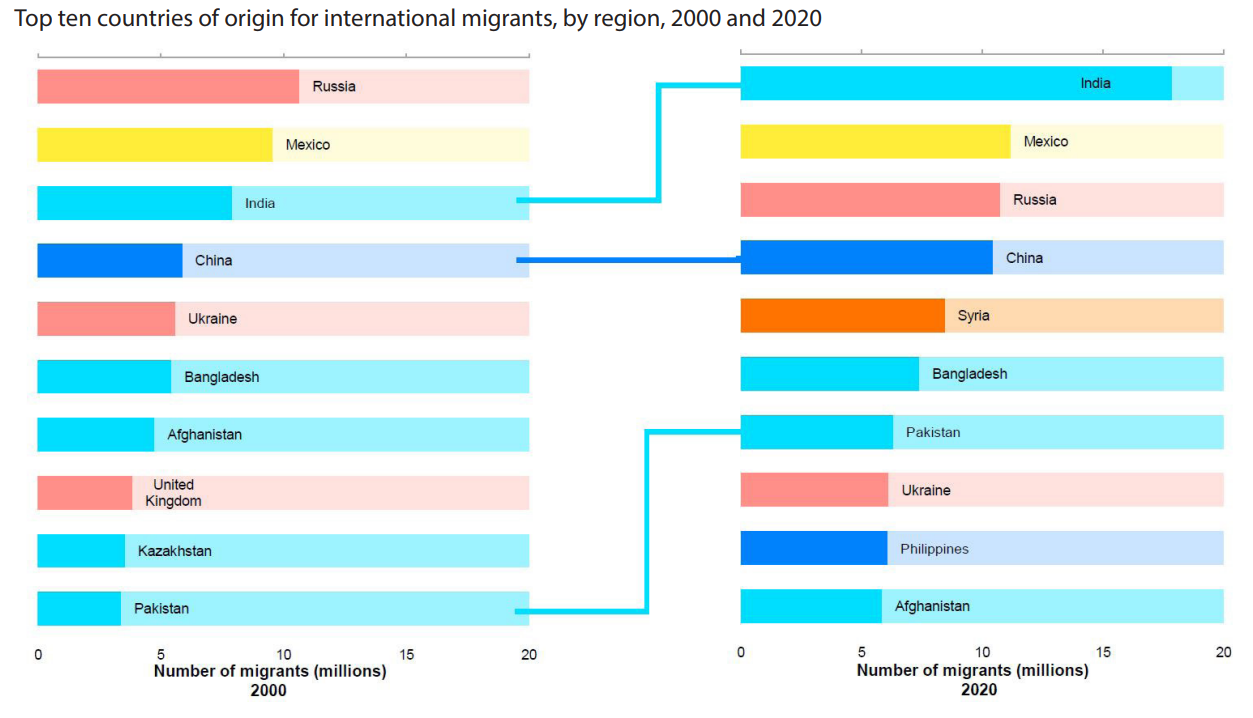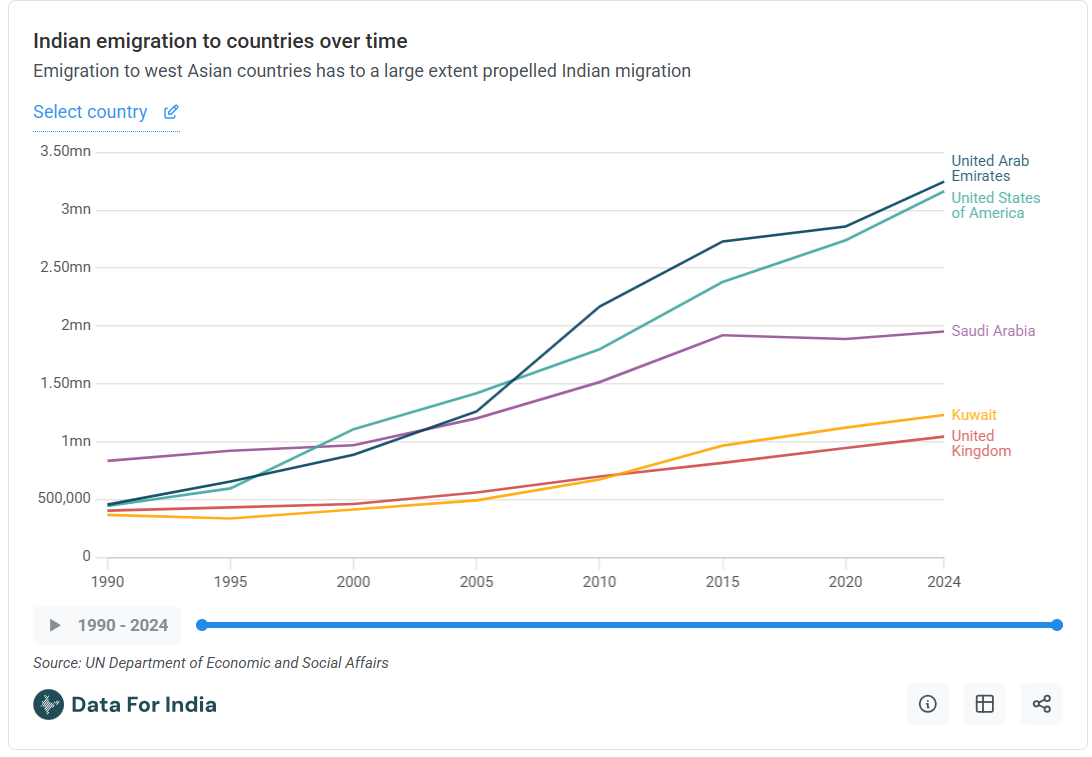
Moonpreneur
Notes: From 2010 to 2025, the top 10 countries with the most prominent Indian population witnessed remarkable growth in their Indian diaspora.
Update: This article was last updated on 9th April 2025 to reflect the accuracy and up-to-date information on the page.
Statistics of Indians Abroad
| Country | Indian Population | % of the total population |
|---|---|---|
| USA | 5.4 Million | 1.55% |
| UAE | 4 Million | 37.96% |
| Malaysia | 3 Million | 6.6% |
| Saudi Arabia | 2.7 Million | 7.8% |
| United Kingdom (UK) | 1.9 Million | 3.1% |
| South Africa | 1.7 Million | 2.62% |
| Myanmar | 2.5 Million | 4.5% |
| Sri Lanka | 1.6 Million | 6.88% |
| Canada | 2.8 Million | 6.9% | Kuwait | 1. Million | 21% |
Source: https://businessconnectindia.in/t
India’s vibrant culture and diverse population have resulted in a significant diaspora spread across the globe. Over the past decade, the Indian population in various countries has experienced remarkable growth.
Among these, the largest Indian population outside of India can be found in countries like the United States, the United Arab Emirates, and Kuwait. These Indians have made significant contributions to numerous fields, including technology and health, business and education, and have created strong links between India and the rest of the world.
Recommended Reading: THE TREND OF H1B VISA FILED FROM FY 2007-2020: BENEFICIARY COUNTRY OF BIRTH
The UN Report said that the distribution of global populations varies significantly across different regions. India’s diaspora, which is the largest in the world, is dispersed across various prominent destination countries. Between 2000 till now 2025 the size of the migrant population abroad grew for nearly all countries and areas of the world. India experienced the most significant gain (nearly 18.5 million) during that period.

Source: UN-Department of Economic and Social Affairs
In this blog, we will analyze the growth trends from 2010 to 2025 of the top 10 countries with Indian population, shedding light on the factors driving this expansion.
United States of America (USA)
The Indian diaspora in the United States showed remarkable growth from 2.84 million in 2010 to 5.4 million in 2025. Factors such as employment opportunities, advanced education systems, and a diverse cultural atmosphere contributed to the steady increase in the Indian population.
United Arab Emirates (UAE)
From 2.21 million in 2010 to 4.00 million in 2025, the Indian population in the UAE has grown significantly. With its substantial economic opportunities and welcoming environment for expatriates, the UAE attracted many Indian immigrants during this period.
Malaysia
During 2010-2025, Malaysia witnessed a consistent influx of 2.32 to 3 million Indian immigrants. The Indian population in Malaysia grew steadily, with Indian professionals contributing to sectors such as information technology and manufacturing.
Saudi Arabia
Saudi Arabia has long been a preferred destination for Indian expatriates, especially in fields like construction, healthcare, and engineering. Over the years, the Saudi Arabia Indian population has witnessed remarkable growth, with the total Indian population in Saudi Arabia increasing from 1.54 million to 2.7 million between 2010 and 2025. This steady rise highlights the strong presence and contributions of Indian professionals and workers in the country.
If you are wondering how many Indians live in Saudi Arabia today, the number stands at approximately 2.7 million, making them one of the largest expatriate communities in the region. The Indian workforce plays a crucial role in Saudi Arabia’s economy, with a significant presence in both skilled and unskilled sectors. The increasing number of Indian professionals, entrepreneurs, and laborers further strengthens the ties between India and Saudi Arabia, showcasing the importance of this growing diaspora.
United Kingdom (UK)
The United Kingdom has a long history of Indian immigration, from 1.45 to 1.9 million. Indians in the UK played a significant role in various sectors, including finance, healthcare, education, and technology.
South Africa
South Africa, with its historical connection to the Indian subcontinent, saw the Indian population grow steadily from 1.30 to 1.7 million. Descendants of indentured laborers who arrived in the 19th century contributed to the vibrant Indian community in the country.
 This image reveals that In 1990, Saudi Arabia was the country with the highest number of Indian-born emigrants, except for Pakistan. In 2024, the UAE and the USA were the top destinations, each having 17% of Indian emigrants.
This image reveals that In 1990, Saudi Arabia was the country with the highest number of Indian-born emigrants, except for Pakistan. In 2024, the UAE and the USA were the top destinations, each having 17% of Indian emigrants.
Myanmar
The Indian population in Myanmar experienced notable growth from 1.20 to 2.5 million. Proximity, historical ties, and opportunities in trade and employment have led to a substantial Indian presence.
Sri Lanka
Sri Lanka shares close cultural and historical ties with India, resulting in a sizable Indian population. From 1 million to 1.6 the Indian community in Sri Lanka continued to contribute to various sectors, primarily in urban areas.
Canada
Canada has emerged as a more desirable destination for Indian immigrants, with 2.8 million settling there between 2010 and 2025. Friendly immigration policies, plenty of economic opportunities, and a high standard of living have helped fuel the significant growth of the Indian population.
Kuwait
As of 2025, Kuwait is largely dependent on Indian labor. There are approximately 1 million Indians residing in Kuwait, which is the largest number of foreigners in Kuwait. They constitute 21% of Kuwait’s population and 30% of its workforce.
Conclusion
Between 2010 and 2025, the Indian diaspora in the top 10 countries with Indian population grew significantly. Economic growth, good education systems, and historical links were significant drivers of this growth. The Indian diaspora still plays a vital role in cultural diversity, economic development, and international relations, creating an intense feeling of global interconnection.
Moonpreneur is on a mission to disrupt traditional education and future-proof the next generation with holistic learning solutions. Its Innovator Program is building tomorrow’s workforce by training students in AI/ML, Robotics, Coding, IoT, and Apps, enabling entrepreneurship through experiential learning.























There are so many challenges faced by the Indian diaspora in these countries, don’t you think the interests of people are affected?
Prominent individuals of Indian origin occupy influential political positions in several countries, boasting India’s political influence on the global stage, particularly within multilateral organizations such as the United Nations. Tulsi Gabbard is a Congresswoman from Hawaii and is a candidate in the 2020 US presidential election
I have a friend who immigrated to Canada during this period due to favorable policies. It’s fascinating to see how these factors discussed in the article influenced real-life decisions.
Economic opportunities and political stability have been equally influential apart from historical ties that are the primary reason for Indian population growth in the UAE.
Do you think the Indian Diaspora will continue to grow in the years 2010-2022?
It is anticipated that the Indian diaspora will continue to increase from 2010 to 2022, reaching 32.28 million people by 2023.
What countries are likely to host a large Indian population in the years to come?
The US, UAE, Saudi Arabia, Malaysia, and the UK are important travel destinations because of their economic potential, educational possibilities, familial links, and lifestyle preferences. Singapore, Qatar, Canada, and Australia are more possible centers.
What factors do you think will shape the future of Indian diasporas?
Global economic trends, technological developments, and pro-diaspora government policies are driving this rise and underscoring the diaspora’s growing influence on the world stage